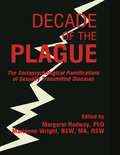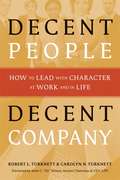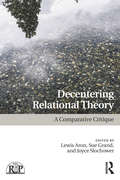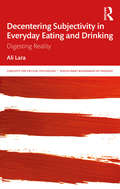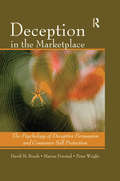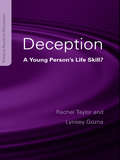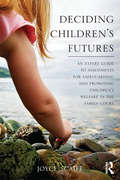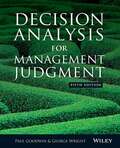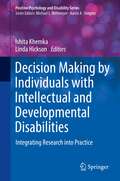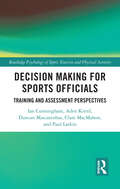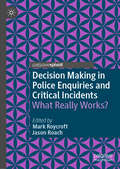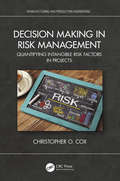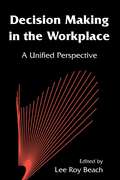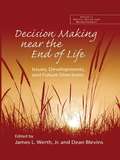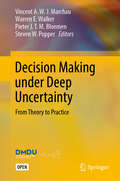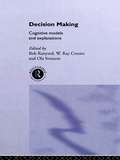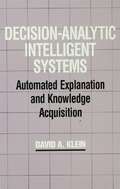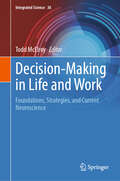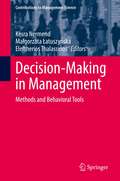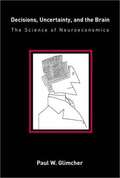- Table View
- List View
Decade of the Plague: The Sociopsychological Ramifications of Sexually Transmitted Diseases
by Margaret R Rodway Marianne WrightSocial workers, counselors, and health care professionals will be challenged by this thorough presentation of Sexually Transmitted Diseases (STDs). The contributing authors contend that in the immediate future, education, not medicine will be the single most important weapon in stemming the spread of STDs. Thus, the responsibility of educating society and providing service for people who are directly or indirectly affected by STDs lies with helping professions. The devastating social, medical, and psychological aspects of AIDS, herpes, and other STDs are discussed. Contributors focus on the issues involved with counseling individuals with STDs--and their partners, families, and friends--and make suggestions for the education and teaching of professionals and the general public about STDs.
Decent People, Decent Company: How to Lead with Character at Work and in Life
by Robert L. Turknett Carolyn N. Turknett Kent C. NelsonThe inspiring people who lead with integrity, move things forward, garner commitment from others and are willing to ask the tough questions when necessary are the real leaders who generate and sustain cultures of character in organizations. Decent People, Decent Company puts the power to develop the core qualities of leadership character into the hands of anyone dedicated to bringing integrity, respect and personal responsibility back to the workplace. Drawing on more than 25 years of experience working with hundreds of CEOs, managers and teams, this innovative husband-and-wife team provides both the inspiration and the tools to help people move from asking "Why don't they?" to asking "What can I?" With their original and dynamic Leadership Character Model, the Turknetts have captured the essence of what it takes to revitalize attitudes and behavior, unleash leadership integrity and reinvigorate organizations. Decent People, Decent Company identifies the eight essential traits of leadership character: empathy, emotional mastery, lack of blame, humility, accountability, courage, self-confidence and focus on the whole. In chapters that focus on each quality, dozens of leaders bring to life the struggles and triumphs of developing the behaviors of character and ethical leadership required to bring out the best in everyone.
Decentering Relational Theory: A Comparative Critique (Relational Perspectives Book Series)
by Lewis Aron, Sue Grand, and Joyce SlochowerDecentering Relational Theory: A Comparative Critique invites relational theorists to contemplate the influence, overlaps, and relationship between relational theory and other perspectives. Self-critique was the focus of De-Idealizing Relational Theory. Decentering Relational Theory pushes critique in a different direction by explicitly engaging the questions of theoretical and clinical overlap – and lack thereof – with writers from other psychoanalytic orientations. In part, this comparison involves critique, but in part, it does not. It addresses issues of influence, both bidirectional and unidimensional. Our authors took up this challenge in different ways. Like our authors in De-Idealizing, writers who contributed to Decentering were asked to move beyond their own perspective without stereotyping alternate perspectives. Instead, they seek to expand our understanding of the convergences and divergences between different relational perspectives and those of other theories. Whether to locate relational thought in a broader theoretical envelope, make links to other theories, address critiques leveled at us, or push relational thinking forward, our contributors thought outside the box. The kinds of comparisons they were asked to make were challenging. We are grateful to them for having taken up this challenge. Decentering Relational Theory: A Comparative Critique will appeal to psychoanalysts and psychoanalytic psychotherapists across the theoretical spectrum.
Decentering Subjectivity in Everyday Eating and Drinking: Digesting Reality (Concepts for Critical Psychology)
by Ali LaraThis important book offers a model to analyze the configurations of reality as manifested in everyday practices of eating and drinking in relation to the development of human subjectivity. The author uses concrete examples from daily life related to eating and drinking habits such as "eating tacos" or "taking a shot of mezcal", to offer an interface of interaction between body/mind and material entities connecting all scales of reality. Borrowing scientific insights from molecular biology and neuroscience, combined with a touch of decolonial spirit, the author examines specific 'processes' and/or 'objects' triggered by eating and drinking events, such as the production of heat as you eat a taco, or the interchange of knowledge while drinking mezcal. The book develops an approach to human subjectivity informed by material and aesthetic encounters beyond the analysis of language, representation, and social structures and aims to contribute to the contemporary landscape of efforts decentering our understanding of both human and non-human affairs. With its multidimensional exploration of our relationship with food, this is thought-provoking reading for scholars and students in critical psychology, philosophy, and the social sciences.
Deception In The Marketplace: The Psychology of Deceptive Persuasion and Consumer Self-Protection
by Peter Wright David M. Boush Marian FriestadThis is the first scholarly book to fully address the topics of the psychology of deceptive persuasion in the marketplace and consumer self-protection. Deception permeates the American marketplace. Deceptive marketing harms consumers’ health, welfare and financial resources, reduces people’s privacy and self-esteem, and ultimately undermines trust in society. Individual consumers must try to protect themselves from marketers’ misleading communications by acquiring personal marketplace deception-protection skills that go beyond reliance on legal or regulatory protections. Understanding the psychology of deceptive persuasion and consumer self-protection should be a central goal for future consumer behavior research. The authors explore these questions. What makes persuasive communications misleading and deceptive? How do marketing managers decide to prevent or practice deception in planning their campaigns? What skills must consumers acquire to effectively cope with marketers’ deception tactics? What does research tell us about how people detect, neutralize and resist misleading persuasion attempts? What does research suggest about how to teach marketplace deception protection skills to adolescents and adults? Chapters cover theoretical perspectives on deceptive persuasion; different types of deception tactics; how deception-minded marketers think; prior research on how people cope with deceptiveness; the nature of marketplace deception protection skills; how people develop deception protection skills in adolescence and adulthood; prior research on teaching consumers marketplace deception protection skills; and societal issues such as regulatory frontiers, societal trust, and consumer education practices. This unique book is intended for scholars and researchers. It should be essential reading for upper level and graduate courses in consumer behavior, social psychology, communication, and marketing. Marketing practitioners and marketplace regulators will find it stimulating and authoritative, as will social scientists and educators who are concerned with consumer welfare.
Deception: A Young Person's Life Skill? (Studies in Adolescent Development)
by Rachel Taylor Lynsey GoznaThis book considers the role of deception during adolescence, and explores the factors which underpin adolescents’ choice to deceive, whether these deceptions will be successful, and the ways in which such lies could be detected. While deception is considered to be antisocial or even pathological in some circumstances, the central argument of this book is that lying can be a skilled behaviour which is necessary to allow adolescents to establish autonomy. Deception builds on the recent influential developmental challenge model (Hendry and Kloep, 2002, 2009), exploring how it can provide a useful explanatory framework for the development of the skill of deception in adolescence. Interpersonal and forensic settings for deceptive behaviour are referred to, and illustrated with reference to both published research and new data obtained from a variety of different interviews and focus groups with young people. It also considers how the choice to communicate truthfully is as important as the choice to communicate deceptively in illuminating the developmental process. It concludes with a discussion of how adolescents’ deceptions could be detected and presents a range of strategies to maximize the effectiveness of interpersonal interactions with suspected deceivers. By considering everyday, forensic and clinical deception situations, this book is ideal for academic researchers, practitioners working with children and young people, as well as parents. The observations, interviews and focus groups provide a unique insight into the factors influencing young people’s communication choices, and integrate research from developmental, social and forensic psychology.
Deciding Children's Futures: An Expert Guide to Assessments for Safeguarding and Promoting Children's Welfare in the Family Court
by Joyce ScaifeDeciding Children’s Futures addresses the thorny task of how to assess parents and children who belong to struggling families where there are issues of neglect or significant harm, and when separating parents are contesting arrangements for the care of their children. This is a practitioner’s guide: it discusses how to create relationships that are capable of breaching natural parental defences to assessment; the importance of keeping an open mind, how to ask questions that fathom people’s experiences, and how to develop understanding of their histories, narratives, worries, hopes and fears. Joyce Scaife’s approach draws on practice knowledge, theory and research findings with a view to integrating the accounts of parents and children with safeguarding imperatives and government guidance, thereby enabling professionals to make informed decisions designed to impact positively on children’s futures. This accessible and comprehensive book will be of great interest to ‘expert’ witnesses, practising social workers, children’s guardians, solicitors, barristers, magistrates and mental health professionals. Joyce Scaife is a clinical psychologist with over 15 years of experience in carrying out assessments for the family court. She is former Director of Clinical Practice for the Doctor of Clinical Psychology training course at the University of Sheffield.
Deciding Children's Futures: An Expert Guide to Assessments for Safeguarding and Promoting Children's Welfare in the Family Court
by Joyce ScaifeThe second edition of Deciding Children’s Futures addresses the thorny task of assessing parents and children who belong to struggling families where there are issues of neglect or significant harm, and when separating parents are contesting arrangements for the care of their children in the family court. This practitioner’s guide discusses how to create relationships and pose questions that breach natural parental defences to understand their histories, anxieties, and needs. Drawing on practice knowledge, theory, and research findings, it integrates the accounts of parents and children with safeguarding imperatives and government guidance, to enable informed decisions that positively impact children’s futures. Chapters address issues such as drug and alcohol misuse, mental health difficulties and learning disabilities, Fabricated or Induced Illness (FII) abuse, and alienation of children, and encourage readers to consider the impact of their own values, histories, and beliefs on the assessment process. This edition is completely updated to reflect all the factors that have impacted assessments for the family court, including updates to case law and procedure rules, devolution of governments, and updates to DSM and ICD diagnostic categories. Providing a comprehensive understanding of assessment for the family court, this user-friendly volume will be of great interest to expert witnesses, social workers, mental health professionals, solicitors, and anyone working in the family court system.
Decision Analysis for Management Judgment
by George Wright Paul GoodwinDecision Analysis for Management Judgment is unique in its breadth of coverage of decision analysis methods. It covers both the psychological problems that are associated with unaided managerial decision making and the decision analysis methods designed to overcome them. It is presented and explained in a clear, straightforward manner without using mathematical notation. This latest edition has been fully revised and updated and includes a number of changes to reflect the latest developments in the field.
Decision Analysis for Management Judgment
by Paul Goodwin and George WrightDecision Analysis for Management Judgment is unique in its breadth of coverage of decision analysis methods. It covers both the psychological problems that are associated with unaided managerial decision making and the decision analysis methods designed to overcome them. It is presented and explained in a clear, straightforward manner without using mathematical notation. This latest edition has been fully revised and updated and includes a number of changes to reflect the latest developments in the field.
Decision Making And Problem Solving: A Practical Guide For Applied Research
by Sachi Nandan MohantyIn Decision Making and Problem Solving: A Practical Guide for Applied Research, the author utilizes traditional approaches, tools, and techniques adopted to solve current day-to-day, real-life problems. The book offers guidance in identifying and applying accurate methods for designing a strategy as well as implementing these strategies in the real world. The book includes realistic case studies and practical approaches that should help readers understand how the decision making occurs and can be applied to problem solving under deep uncertainty.
Decision Making and Modelling in Cognitive Science
by Sisir RoyThis book discusses the paradigm of quantum ontology as an appropriate model for measuring cognitive processes. It clearly shows the inadequacy of the application of classical probability theory in modelling the human cognitive domain. The chapters investigate the context dependence and neuronal basis of cognition in a coherent manner. According to this framework, epistemological issues related to decision making and state of mind are seen to be similar to issues related to equanimity and neutral mind, as discussed in Buddhist perspective. The author states that quantum ontology as a modelling tool will help scientists create new methodologies of modelling in other streams of science as well.
Decision Making by Individuals with Intellectual and Developmental Disabilities: Integrating Research into Practice (Positive Psychology and Disability Series)
by Ishita Khemka Linda HicksonThis book examines theoretical considerations in the study of decision making as well as practical applications in social interpersonal domains for adolescents and adults with intellectual and developmental disabilities (IDD). It provides a history of the study of decision making in individuals with IDD and examines emerging views on decision making from a positive psychology perspective. The book explores the role of decision making in self-determination as well as offers global perspectives on the rights and responsibilities of individuals with IDD to engage in independent decision making. It outlines a framework for the study of decision making in individuals with IDD, reviews research that addresses the role of culturally diverse influences on individual decision making, and examines likely consequences of the etiological bases of disability on decision-making profiles. Key areas of coverage include: · Critical role of basic processes of cognition, motivation and self-beliefs, affect and emotion, and various styles of decision making. · Applications of decision-making skills within family and community contexts, in personal and social relationships, during transition to adulthood and more independent lifestyles, and in successful community living. · Self-protective decision making by individuals in situations of abuse as well as in resisting peer victimization and bullying. · Decision-making parameters for enabling maximum participation in self-decision making, through shared and supported decision making in contexts such as health care, aging, and end-of-life decisions. · Research-based interventions to improve effective decision making in individuals with IDD.Decision Making by Individuals with Intellectual and Developmental Disabilities is a must-have reference for researchers, professors, and graduate students as well as clinicians and other professionals in the fields of developmental and positive psychology, rehabilitation, social work, special education, occupational, speech and language therapy, public health, and healthcare policy.
Decision Making for Sports Officials: Training and Assessment Perspectives (Routledge Psychology of Sport, Exercise and Physical Activity)
by Clare MacMahon Duncan Mascarenhas Ian Cunningham Paul Larkin Aden KittelThis essential guidebook provides a comprehensive, holistic, and evidence-based account for improving the decision making of sports officials across different sports and levels. By combining cutting-edge research with practical strategies, this book provides fundamental frameworks for developing decision-making skills that support the needs of officials themselves, officiating educators, sport organizations, and academics. This cross-disciplinary collaboration ensures the book stays grounded in both theory and practice, offering readers a well-rounded, state-of-the-art understanding of the subject.Divided into three key sections, the book first explores the unique demands and types of decisions faced by officials in different sports. Next, fundamental cognitive and mental factors that influence decision making are explained, emphasizing the creation of knowledge, the influences on decision processes, and the role of mental health and psychological management on decision-making performance. Finally, the book outlines pragmatic and innovative strategies for supporting, assessing, and training decision making and creating effective development climates for sports officials. Future trends in the evolution of technology use for training and assessing officials – spanning grassroots to elite levels – are also discussed, including artificial intelligence (AI), virtual reality (VR), and other immersive learning tools.Each chapter is enriched by "Knowledge in Practice" boxes, which bring the experiences and perspectives of sports officials, officiating educators and administrators, and sports scientists from around the globe to light. These provide real-world examples and lessons for how decision making can be improved in various sporting contexts.Decision Making for Sports Officials: Training and Assessment Perspectives is a core resource for enhancing decision making in the high-stakes world of sports officiating.
Decision Making in Health and Medicine
by Joseph S. Pliskin M.G. Myriam Hunink Milton C. Weinstein Eve Wittenberg Michael F. Drummond Joseph S. Pliskin John B. Wong Paul P. Glasziou M.G. Myriam Hunink Milton C. Weinstein Eve Wittenberg Michael F. Drummond John B. WongDecision making in health care means navigating through a complex and tangled web of diagnostic and therapeutic uncertainties, patient preferences and values, and costs. In addition, medical therapies may include side effects, surgery may lead to undesirable complications, and diagnostic technologies may produce inconclusive results. In many clinical and health policy decisions it is necessary to counterbalance benefits and risks, and to trade off competing objectives such as maximizing life expectancy vs optimizing quality of life vs minimizing the required resources. This textbook plots a clear course through these complex and conflicting variables. It clearly explains and illustrates tools for integrating quantitative evidence-based data and subjective outcome values in making clinical and health policy decisions. An accompanying CD-ROM features solutions to the exercises, PowerPoint® presentations of the illustrations, and sample models and tables.
Decision Making in Police Enquiries and Critical Incidents: What Really Works?
by Jason Roach Mark RoycroftThis book examines how the police make decisions in real life situations, particularly in major enquiries. The two key themes explored are real-time decision making along with what “works” in such circumstances. It aims to set out how successful decisions are arrived at in a variety of difficult and time-constrained situations and discusses the lessons that can be learnt from this. Written by practitioners and academics, the book explores a range of topics, from the decision making process involved operational matters and in difficult-so-solve murder enquiries. It not only examines decision making but also how experienced decision makers function. It looks at the psychology of police decision making, decision making involved in cold case investigations, and discusses the need for “grip” during major investigations. The contributors are experienced and respected practitioners and academics This book will appeal particularly to those studying Policing and Criminology and also to Investigating Officers and those involved in professionalising investigative practice.
Decision Making in Risk Management: Quantifying Intangible Risk Factors in Projects (Manufacturing and Production Engineering)
by Christopher O. CoxProject risk management is regarded as a necessary dimension of effective project delivery. Current practices tend to focus on tangible issues such as late delivery of equipment or the implications of technology. This book introduces a framework to identify emergent behavior-centric intangible risks and the conditions that initiate them. Decision Making in Risk Management: Quantifying Intangible Risk Factors in Projects identifies the quantitative measures to assess behavior-induced risks by presenting a framework that limits the interpersonal tension of addressing behavioral risks. Included in the book is an illustrative case study from the oil and gas sector that demonstrates the use of the framework. The missing dimension of behavior-centric intangible risk factors in current risk identification is explored. The book goes on to cover management processes, providing a systematic analytical approach to mitigate subjectivity when addressing behavioral risks in projects. This book is useful to those working in the fields of Project Management, Systems Engineering, Risk Management, and Behavioral Science.
Decision Making in the Workplace: A Unified Perspective
by Lee Roy BeachMany, if not most, of one's important decisions are made in the context of one's work. However, because workplace decisions cover such a broad range of issues, it often is difficult to detect underlying commonalities in how they are made, and in how things go wrong when they do go wrong. As a result, there are nearly as many different descriptions of workplace decisions as there are decisions themselves. In this volume, the best features of these diverse descriptions are unified in a new, intuitively compelling view of decision making called "Image Theory." The result is a clear picture of real-life, day-to-day workplace decision making that allows us to think constructively about how such decisions are made and about how to improve them when improvement is necessary.
Decision Making near the End of Life: Issues, Developments, and Future Directions (Series in Death, Dying, and Bereavement)
by James L. Werth Jr. Dean BlevinsDecision Making near the End of Life provides a comprehensive overview of the recent developments that have impacted decision-making processes within the field of end-of-life care. The most current developments in all aspects of major underlying issues such as public attitudes, the impact of media, bioethics, and legal precedent provide the background information for the text. The authors examine various aspects of end-of-life choices and decision-making, including communication (between and among family, medical personnel, the dying person), advance directives, and the emergence of hospice and palliative care institutions. The book also explores a variety of psychosocial considerations that arise in decision-making, including religion/spirituality, family caregiving, disenfranchised and diverse groups, and the psychological and psychiatric problems that can impact both the dying person and loved ones. Case studies and first-person stories about decision-making, written by professionals in the field, bring a uniquely personal touch to this valuable text.
Decision Making under Deep Uncertainty: From Theory To Practice
by Steven W. Popper Warren E. Walker Vincent A. W. J. Marchau Pieter J. T. M. BloemenThis open access book focuses on both the theory and practice associated with the tools and approaches for decisionmaking in the face of deep uncertainty. It explores approaches and tools supporting the design of strategic plans under deep uncertainty, and their testing in the real world, including barriers and enablers for their use in practice. The book broadens traditional approaches and tools to include the analysis of actors and networks related to the problem at hand. It also shows how lessons learned in the application process can be used to improve the approaches and tools used in the design process. The book offers guidance in identifying and applying appropriate approaches and tools to design plans, as well as advice on implementing these plans in the real world. For decisionmakers and practitioners, the book includes realistic examples and practical guidelines that should help them understand what decisionmaking under deep uncertainty is and how it may be of assistance to them. <p><p> Decision Making under Deep Uncertainty: From Theory to Practice is divided into four parts. Part I presents five approaches for designing strategic plans under deep uncertainty: Robust Decision Making, Dynamic Adaptive Planning, Dynamic Adaptive Policy Pathways, Info-Gap Decision Theory, and Engineering Options Analysis. Each approach is worked out in terms of its theoretical foundations, methodological steps to follow when using the approach, latest methodological insights, and challenges for improvement. In Part II, applications of each of these approaches are presented. Based on recent case studies, the practical implications of applying each approach are discussed in depth. Part III focuses on using the approaches and tools in real-world contexts, based on insights from real-world cases. Part IV contains conclusions and a synthesis of the lessons that can be drawn for designing, applying, and implementing strategic plans under deep uncertainty, as well as recommendations for future work.
Decision Making: Cognitive Models and Explanations (Frontiers of Cognitive Science #Vol. 1)
by W. Ray Crozier Rob Ranyard Ola SvensonThis book offers an exciting new collection of recent research on the actual processes that humans use when making decisions in their everyday lives and in business situations. The contributors use cognitive psychological techniques to break down the constituent processes and set them in their social context. The contributors are from many different countries and draw upon a wide range of techniques, making this book a valuable resource to cognitive psychologists in applied settings, economists and managers.
Decision-Analytic Intelligent Systems: Automated Explanation and Knowledge Acquisition
by David A. KleinThis book presents a framework for building intelligent systems based on the mathematical decision models of Decision Analysis. The author provides new techniques for automated explanation and knowledge acquisition in formally sound systems that reason about complex tradeoffs in decisions. Also included are specifications for implementing these techniques in computer programs, along with demonstration applications in marketing, process control, and medicine. Readers with an interest in artificial intelligence will gain a foundation for building formally justifiable, intelligible, modifiable systems for computing decisions involving multiple considerations, with applications across a variety of domains. Beyond decision models, the methodology of the work reported suggests a more general approach to employing formal mathematical models in transparent intelligent systems. Decision-analysis experts will find a collection of methods for explaining decision-analytic advice to clients in intuitive terms, for simplifying parameter assessment, and for managing changing preferences over time. The book provides sufficient background material to promote understanding by readers who may be unfamiliar with artificial intelligence, with decision analysis, or with both fields, and such material is labeled to increase the well-versed reader's efficiency in skipping particular sections.
Decision-Making in Life and Work: Foundations, Strategies, and Current Neuroscience (Integrated Science #36)
by Todd McElroyThis groundbreaking volume brings together leading researchers to explore the latest findings on the psychological and physiological factors that shape decision-making. It offers a uniquely multidisciplinary perspective, integrating insights from neuroscience, economics, public policy, and other fields to provide a comprehensive understanding of how we make choices in both personal and professional contexts. Designed for researchers, professionals, instructors, and students interested in decision science, this book delves into several key areas. It explores the cognitive biases and heuristics that influence our decisions. The book also examines the role of emotions and intuition in decision-making. Additionally, it investigates the neuroscience behind information processing and judgment. It also provides strategies we can use to make better decisions in real-world settings. The chapters, written by experts in the field, cover a wide range of topics ranging from the foundations of decision theory to the latest research on the neural bases of decision-making, providing readers with a rich understanding of the subject. Through its multidisciplinary approach and emphasis on practical applications, this volume offers readers valuable insights and tools for enhancing their own decision-making skills. Whether you are a researcher studying decision-making processes, a professional looking to make better judgments in important situations, or an instructor teaching decision science, this book provides a comprehensive and accessible resource that will deepen your understanding of this critical area of human behavior.
Decision-Making in Management: Methods and Behavioral Tools (Contributions to Management Science)
by Kesra Nermend Małgorzata Łatuszyńska Eleftherios ThalassinosMaking important business decisions is usually a difficult and complicated task. In the modern economy where businesses have to solve increasingly complex decision-making problems, it is important to learn and use methods and techniques including the analysis of behavioral data to support decision-making in practice.This book presents various methods and solutions to problems in modern data acquisition techniques and practical aspects of decision making. In particular, it addresses such important issues as: business decision making, multi-criteria decision analysis (MCDA), multidimensional comparative analysis (MCA), decision games and data acquisition techniques for decision making (declarative techniques and cognitive neuroscience techniques). Important topics such as consumers’ rational behavior, environmental management accounting, operational research methods, neuroscience including epigenetics, DEA analysis etc., as well as case studies related to decision making in management are also included.
Decisions, Uncertainty, and the Brain
by Paul W. GlimcherWinner in the category of Medical Science in the 2003 Professional/Scholarly Publishing Annual Awards Competition presented by the Association of American Publishers, Inc. In this provocative book, Paul Glimcher argues that economic theory may provide an alternative to the classical Cartesian model of the brain and behavior. Glimcher argues that Cartesian dualism operates from the false premise that the reflex is able to describe behavior in the real world that animals inhabit. A mathematically rich cognitive theory, he claims, could solve the most difficult problems that any environment could present, eliminating the need for dualism by eliminating the need for a reflex theory. Such a mathematically rigorous description of the neural processes that connect sensation and action, he explains, will have its roots in microeconomic theory. Economic theory allows physiologists to define both the optimal course of action that an animal might select and a mathematical route by which that optimal solution can be derived. Glimcher outlines what an economics-based cognitive model might look like and how one would begin to test it empirically. Along the way, he presents a fascinating history of neuroscience. He also discusses related questions about determinism, free will, and the stochastic nature of complex behavior.
